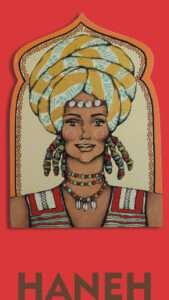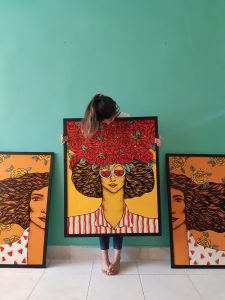By: Ghazal Mostafa
Afrouz Rajaei was born in 1987. She studied graphic design at Isfahan University of Art, located in Isfahan where she currently lives. Before starting her own company, Haneh Design, Rajaei used to work with screen printing on fabric. The process took place in a warehouse whereby illustrations were printed onto fabric, which would be turned into clothing. At the time, 10 to 12 years ago, this process was not widely used. After many years of working with fabrics, she was invited to an art exhibition in Turkey, which started her career of illustrating on different mediums such as pottery. Rajaei found that this new medium had more potential than screen printing. Rajaei is currently the manager of Haneh Design. Along with her husband, Navid, they come up with the main creative ideas and their team carries them out.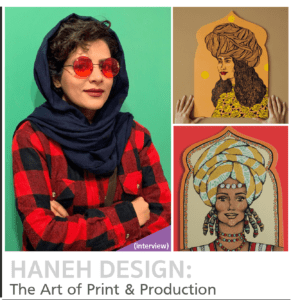
How did Haneh Design start and how long has it been active for?
My partner and I used to work in print and production. After a period of time, I began to work for an exhibition in Turkey and drew several illustrations on plates and clay spoons, which the customers really enjoyed. Notably, I have always preferred this type of work. After approximately one year, my husband Navid began encouraging me to showcase my work on Instagram. My expectation was for my work to eventually be showcased in exhibitions, not to be sold. Soon after, someone from the Cinema Museum Gallery contacted me and wanted to buy some of my works. I was amazed and felt like I was entering a new world. This was the first time I realized that other people liked my work and wanted to buy them. From then on, my work took shape; I focused more on the colors and shapes of my art and took it more seriously and people started ordering my pieces for themselves or galleries. As a new brand, Haneh Design took about one year to materialize. It has now been about three years that it has been professionally operational and successful.
What materials do you use in your work? What is your creative process? How do you choose the colors you use?
I started by working on clay and ceramics, but for about a year now I have been working on wood. We used to work on a scale ranging between 25 to 30 cm, which then turned into 35cm and it currently goes up to even 1 meter. First, we choose a muse for our work and then we begin to brainstorm, by contemplating which colors to use etc. Our work is affected by many things, such as the mood we start the day with, movies we watch or conversations we have with each other When I first started working, I worked with my husband. I created the drawings and he focused on the rest of the business, such as packaging. The level of work I had eventually went up and we couldn’t keep up with all the work we had to do during the day, so we began posting job listings and were surprised to receive so much interest.
Some people who really enjoyed art began to work with us and I think that, since Navid and I believe that teamwork is important, we were able to efficiently work together as a team. Our belief in them and their hard work help improve our product.
For example, when I want to make a product, they can offer new views and opinions, which has really helped my work. One of our team members, Mahdieh, is someone I always communicate with when choosing colors.
Why did you choose these mediums to show your work?
Since I already had a background in the field of illustration – I used to illustrate book covers – I was used to working on paper and always wondered if illustrations can be done on other platforms. Was it only possible to see illustrations in magazines and books? These thoughts led me to illustrate on plates. It might seem like an inconvenient thing to do, but at the time it was a strange thing to experiment with and I wanted to try it! Although Iranian culture has a history of artwork on plates, I hadn’t seen anyone else do what I was doing. For us and our team, it doesn’t matter what mediums we’ve worked with. We’ve just about worked on every medium, from plates to ceramics to wood. Maybe next year we won’t work with these materials and will move on to another medium. What is important to us is being able to share the positivity of our work from one medium to the next. We want our work to be put up in people’s houses.
What are the meanings of the symbols and elements in your works? Could we say that you are inspired by symbolism in your work?
Yes, why not? I believe that people may unintentionally lean towards the use of symbols; sometimes it is present in our daily lives and could go unnoticed. Either way, it exists in our lives. I have personally seen lots of symbols in my life: fish, water, clouds, for example, could have a different meaning to each person. Sometimes we see symbols and sometimes we don’t. Some symbols are harder to interpret, such as the ocean or even some flowers which take on different shapes, and can be seen differently by each person, each woman.
What else inspires you? How much of your inspiration comes from yourself and/or others?
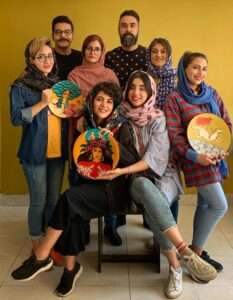 Firstly, I can say that I am inspired by films, books and topics I’ve heard in conversation with other people. I think the most influential are conversations amongst people. This goes back to what I said about symbols, and how sometimes they go unnoticed, but they still really do have an effect on us. One thing I’ve noticed is that people feel good when they’re looking at our art. Navid and I continue encouraging positivity in others when they look at our work, whether it’s because of our behavior, art or style. Since, at the time being, I don’t personally work on every piece of art and have a team that works on them with me, each piece of work takes on the feeling and personality of its artist. I’ve had customers tell me that something they purchased a few months ago looks different to what we sell now, and this is because two different artists worked on those pieces.
Firstly, I can say that I am inspired by films, books and topics I’ve heard in conversation with other people. I think the most influential are conversations amongst people. This goes back to what I said about symbols, and how sometimes they go unnoticed, but they still really do have an effect on us. One thing I’ve noticed is that people feel good when they’re looking at our art. Navid and I continue encouraging positivity in others when they look at our work, whether it’s because of our behavior, art or style. Since, at the time being, I don’t personally work on every piece of art and have a team that works on them with me, each piece of work takes on the feeling and personality of its artist. I’ve had customers tell me that something they purchased a few months ago looks different to what we sell now, and this is because two different artists worked on those pieces.
The difference is particularly visible in the faces of the women we draw, their emotions and expressions. I find it interesting that each artist unintentionally puts their own emotion into their art. It really is unintentional; an artist may intend to draw a happy figure but their own emotion can override that and affect the final result.
Your signature is the women you draw. What draws you to incorporate women in your artwork?
It is completely true that our style lies in drawing women. It might be because of my own womanhood affecting my work, which I connect with and make use of. Furthermore, I know myself and women better than I know men. I find it easier to use my own experiences and connect with my inner feelings. I feel familiar with womanhood, both inside and out.
What is the mission of Haneh Design?
We want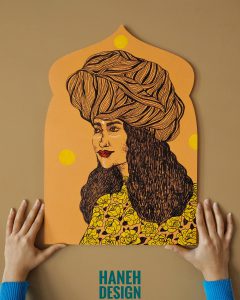 to use our skills to make people feel better and give their homes a unique addition. We also want people to explore and expand their taste and know that they can use their imagination to picture what they could place in their houses. For a long time, it was hard for people to choose art to put up in their homes. We feel honored that Haneh Design can be included in people’s houses, bringing them joy and laughter. I believe that we are all links in a chain and each action has a ripple effect, so we hope ours is a positive one.
to use our skills to make people feel better and give their homes a unique addition. We also want people to explore and expand their taste and know that they can use their imagination to picture what they could place in their houses. For a long time, it was hard for people to choose art to put up in their homes. We feel honored that Haneh Design can be included in people’s houses, bringing them joy and laughter. I believe that we are all links in a chain and each action has a ripple effect, so we hope ours is a positive one.


